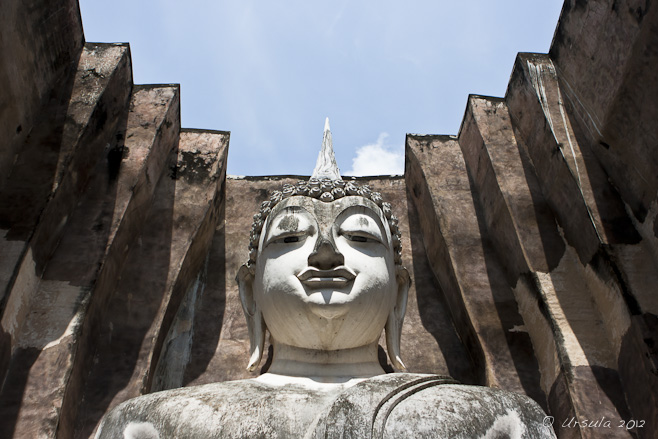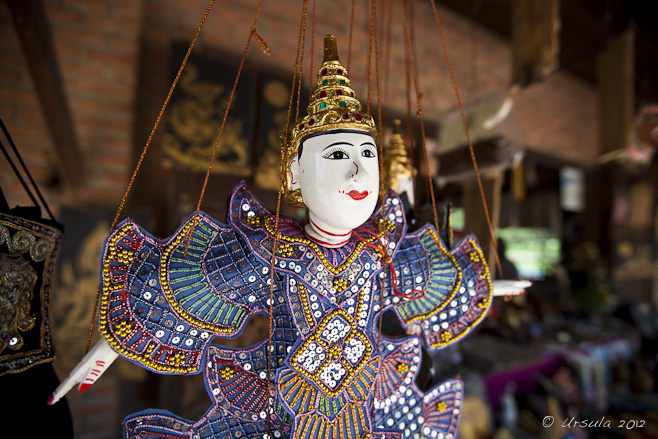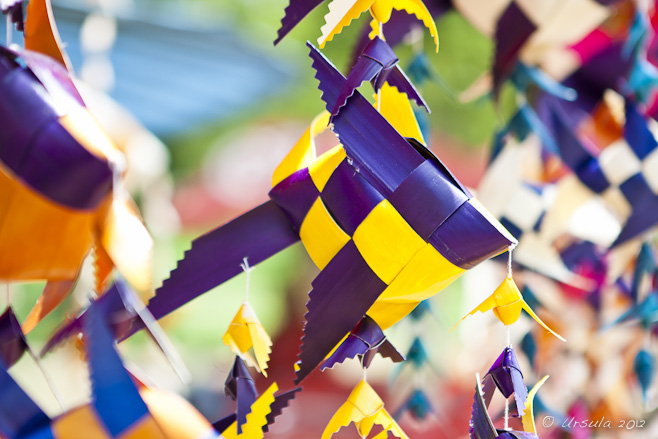
The Phra Achana Buddha of Wat Si Chum
Sukhothai, the UNESCO listed collection of Thai ruins that was, in the 13th and 14th centuries, the capital of the Sukhothai kingdom, is a remarkable place. Inside the ancient walls are the remains of the old royal palace and twenty-six temples. What is even more remarkable, however, is the beauty to be found outside the walls.
Beyond the northern walls of the ancient city of Sukhothai, but still part of the official “Historic Town of Sukhothai and Associated Historic Towns”, are further treasures. When we saw the beautifully crafted marionettes and other carved products at the shops lining the quiet packed-dirt car-park outside Wat Si Chum, we knew we were in for a treat.

Delicate and elaborate marionettes welcome us to the parking lot of the Sukhothai North temples.

Lucky fish mobiles, woven from colourful bamboo, are also for sale.

The Mondop (small square temple building) of 13th Century Wat Si Chum lies at the end of a path across and expanse of grass.

As you get closer, the magnificent “Phra Achana” Buddha statue of Wat Si Chum comes into view behind the three-meter thick walls.

Phra Achana, the 15 meter Buddha seated in the Subduing Mara (Maravijayan: Calling the Earth to Witness) pose, is possibly one of the most beautiful Buddhas I’ve seen.

The lap of the Phra Achana Buddha is 11.5 meters wide. The fingers of the right hand are covered with gold leaf, applied by visitors paying their respects.

The roof of the mondop (mandapa: pavilion for religious ritual) has long-since fallen in, allowing a wonderful view of the sky above.

Close to the Phra Achana mondop is a smaller one built of laterite bricks, housing a smaller seated Buddha.

Bits of gold leaf are pressed to the Buddha’s upturned fingers.

Also north of the ancient city walls is the Khmer style Wat Phra Phai Luang, which pre-dates Sukhothai and was probably built during the reign of the Khmer king, Jayavarman VII (between 1181 and 1219).

Worn and weathered: Buddha head at Wat Phra Phai Luang.

The building was originally a Khmer Mahayana Buddhist temple, built on a site with evidence of earlier Hindu worship. It was later converted to a Theravada Buddhist temple, and today shows the signs of modern Thai worship.

The remains of a giant standing Buddha at Wat Phra Phai Luang.

Even the ruins of these ancient Buddhas have a timeless elegance.

Near the old Wat Phra Phai Luang is the modern Wat Phra Phai Luang, where a new hall is being build.

Inside the unfinished building, a Thai woman lovingly sands the new wooden baseboards. It reminded me of “The Karate Kid”: “Wax on, wax off.” The building of temples is a timeless way of creating calm and making merit.

Meanwhile, in the field outside, a young lad was determined so show me how he could chase the cattle.

Although the cattle are unmoved, I found his joy infectious as he ran around with his slingshot.
 And so, life in all its aspects continues around these ancient temples built by long-dead kings – and we can continue to find joy and beauty in them.
And so, life in all its aspects continues around these ancient temples built by long-dead kings – and we can continue to find joy and beauty in them.
Pictures: 22May2012























Another great series Ursula.
Thanks, Guava! I’m always pleased when you drop by. 🙂
So many Buddah’s, you take wonderful pictures and such beautiful descriptions. Makes you wish you were there.
Another nice photo series Ursula. I’ve been trying to think of a good excuse to return to Thailand (as if excuses are necessary) Sukhothai might be just the ticket! 🙂
Thank you for taking me on your wonderful wander – beautiful images take me there.
Lovely.
Anna :o]
Thanks for the visits, Anna, Signe and Kevin!
Thailand needs no excuse – it is always a delight.
It seems a world away, now, as I sit in the Canadian Northwest, where summer is struggling to happen! 😉